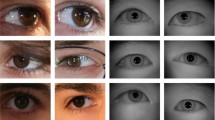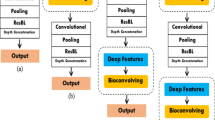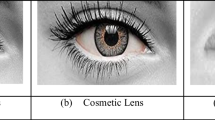Abstract
In this paper, we tackle the twins identification problem; a challenging task in biometric authentication. The experiments are carried out using deep learning techniques and for that we have proposed a Convolutional Siamese Network (CNN-Siamese) and a multiscale Convolutional Siamese network (MCNN-Siamese). We have also explored and evaluated three pre-trained CNNs namely, ResNet-50, VGG-16 and NASNet-Large, and utilized them in Siamese network after appropriate modifications. In addition, a simple 5-layer neural network (sNN) is also utilised as Siamese subnetwork in the experiments. We have presented compelling experimental evidences in terms of correct classification accuracy (CCR) on CASIA-IrisV4 Twins’ dataset that manifest the effectiveness of ocular biometrics in identifying twins. The results achieve the existing state-of-the-art human level accuracy. Also, the proximity of CCRs of all the models asserts that the ocular regions in twins hold a significant correlation to label them as twins. We have also quantified the cross-domain capability of the proposed subnetworks (i.e. CNN and MCNN) on ND-GFI dataset that outperforms the state-of-the-art methods. Notably, for the ocular biometrics, to the best of our knowledge, there is currently no literature available as of date that explores the association between twins and subsequently unriddles the classification using Deep Learning.











Similar content being viewed by others
References
Al Ghamdi M, Li M, Abdel-Mottaleb M, Shousha MA (2019) Semi-supervised transfer learning for convolutional neural networks for glaucoma detection. In: ICASSP 2019-2019 IEEE international conference on acoustics, speech and signal processing (ICASSP). IEEE, pp 3812–3816
Alnujaim I, Alali H, Khan F, Kim Y (2018) Hand gesture recognition using input impedance variation of two antennas with transfer learning. IEEE Sensors J 18(10):4129–4135
Bharadwaj S, Bhatt HS, Vatsa M, Singh R (2010) Periocular biometrics: When iris recognition fails. In: 2010 4th IEEE international conference on biometrics: Theory, applications and systems (BTAS). IEEE, pp 1–6
Bowyer KW, Flynn PJ (2016) Biometric identification of identical twins: A survey. In: 2016 IEEE 8th international conference on biometrics theory, applications and systems (BTAS), pp 1–8. IEEE
Burge MJ, Bowyer K (2013) Handbook of iris recognition. Springer Science & Business Media
Cao F, Liu B, Park DS (2013) Image classification based on effective extreme learning machine. Neurocomputing 102:90–97
CBSR: CASIA-Iris-Twins. http://www.cbsr.ia.ac.cn/english/IrisDatabase.asp
Chatterjee S, Dutta RK, Ganguly D, Chatterjee K, Roy S (2019) Bengali handwritten character classification using transfer learning on deep convolutional neural network. arXiv:1902.11133
Chollet F et al (2015) Keras, GitHub. https://github.com/fchollet/keras
Crihalmeanu S, Ross A, Derakhshani R (2009) Enhancement and registration schemes for matching conjunctival vasculature. In: International conference on biometrics. Springer, pp 1240–1249
Cui Y, Song Y, Sun C, Howard A, Belongie S (2018) Large scale fine-grained categorization and domain-specific transfer learning. In: Proceedings of the IEEE conference on computer vision and pattern recognition, pp 4109–4118
Das A, Pal U, Blumenstein M, Ballester MAF (2013) Sclera recognition-a survey. In: 2013 2nd IAPR Asian conference on pattern recognition. IEEE, pp 917–921
Das A, Roy S, Bhattacharya U, Parui SK (2018) Document image classification with intra-domain transfer learning and stacked generalization of deep convolutional neural networks. In: 2018 24th international conference on pattern recognition (ICPR). IEEE, pp 3180–3185
Daugman J (2009) How iris recognition works. In: The essential guide to image processing. Elsevier, pp 715–739
Deng J, Dong W, Socher R, Li LJ, Li K, Fei-Fei L (2009) Imagenet: A large-scale hierarchical image database. In: IEEE conference on computer vision and pattern recognition, 2009. CVPR 2009. IEEE, pp 248–255
Derakhshani R, Ross A, Crihalmeanu S (2006) A new biometric modality based on conjunctival vasculature. In: Proceedings of artificial neural networks in engineering, pp 1–8
Ding S, Zhang N, Zhang J, Xu X, Shi Z (2017) Unsupervised extreme learning machine with representational features. Int J Mach Learn Cybern 8(2):587–595
Do CB, Ng AY (2006) Transfer learning for text classification. In: Advances in neural information processing systems, pp 299–306
Ferreira CA, Melo T, Sousa P, Meyer MI, Shakibapour E, Costa P, Campilho A (2018) Classification of breast cancer histology images through transfer learning using a pre-trained inception resnet v2. In: International conference image analysis and recognition. Springer, pp 763–770
Habibzadeh M, Jannesari M, Rezaei Z, Baharvand H, Totonchi M (2018) Automatic white blood cell classification using pre-trained deep learning models: Resnet and inception. In: 20th international conference on machine vision (ICMV 2017), vol 10696, p 1069612. International Society for Optics and Photonics
He K, Zhang X, Ren S, Sun J (2016) Deep residual learning for image recognition. In: Proceedings of the IEEE conference on computer vision and pattern recognition, pp 770–778
Hinton GE, Osindero S, Teh YW (2006) A fast learning algorithm for deep belief nets. Neural Comput 18(7):1527–1554
Hinton GE, Salakhutdinov RR (2006) Reducing the dimensionality of data with neural networks. Science 313(5786):504–507
Hollingsworth K, Bowyer KW, Flynn PJ (2010) Similarity of iris texture between identical twins. In: 2010 IEEE computer society conference on computer vision and pattern recognition workshops (CVPRW). IEEE, pp 22–29
Hollingsworth K, Bowyer KW, Lagree S, Fenker SP, Flynn PJ (2011) Genetically identical irises have texture similarity that is not detected by iris biometrics. Comput Vis Image Underst 115(11):1493–1502
Kingma DP, Ba J (2014) Adam: A method for stochastic optimization. arXiv:1412.6980
Koch G, Zemel R, Salakhutdinov R (2015) Siamese neural networks for one-shot image recognition. In: ICML deep learning workshop, vol 2
Kornblith S, Shlens J, Le QV (2019) Do better imagenet models transfer better?. In: Proceedings of the IEEE conference on computer vision and pattern recognition, pp 2661–2671
Krizhevsky A, Sutskever I, Hinton GE (2012) Imagenet classification with deep convolutional neural networks. In: Advances in neural information processing systems, pp 1097–1105
Larochelle H, Bengio Y (2008) Classification using discriminative restricted boltzmann machines. In: Proceedings of the 25th international conference on Machine learning. ACM, pp 536–543
Lim YK, Liao Z, Petridis S, Pantic M (2018) Transfer learning for action unit recognition. arXiv:1807.07556
Miller PE, Rawls AW, Pundlik SJ, Woodard DL (2010) Personal identification using periocular skin texture. In: Proceedings of the 2010 ACM symposium on applied computing. ACM, pp 1496–1500
Nair V, Hinton GE (2010) Rectified linear units improve restricted boltzmann machines. In: Proceedings of the 27th international conference on machine learning (ICML-10), pp 807–814
Nguyen LD, Lin D, Lin Z, Cao J (2018) Deep cnns for microscopic image classification by exploiting transfer learning and feature concatenation. In: 2018 IEEE international symposium on circuits and systems (ISCAS). IEEE, pp 1–5
Oh K, Oh BS, Toh KA, Yau WY, Eng HL (2014) Combining sclera and periocular features for multi-modal identity verification. Neurocomputing 128:185–198
Park U, Jillela RR, Ross A, Jain AK (2010) Periocular biometrics in the visible spectrum. IEEE Trans Inf Forensics Secur 6(1):96–106
Raghavendra R, Raja KB, Yang B, Busch C (2013) Combining iris and periocular recognition using light field camera. In: 2013 2nd IAPR Asian conference on pattern recognition. IEEE, pp 155–159
Reed S, Akata Z, Lee H, Schiele B (2016) Learning deep representations of fine-grained visual descriptions. In: Proceedings of the IEEE conference on computer vision and pattern recognition, pp 49–58
Simonyan K, Zisserman A (2014) Very deep convolutional networks for large-scale image recognition. arXiv:1409.1556
Singh M, Nagpal S, Vatsa M, Singh R, Noore A, Majumdar A (2017) Gender and ethnicity classification of iris images using deep class-encoder. In: 2017 IEEE international joint conference on biometrics (IJCB). IEEE, pp 666–673
Srivastava N, Hinton G, Krizhevsky A, Sutskever I, Salakhutdinov R (2014) Dropout: a simple way to prevent neural networks from overfitting. J Mach Learn Res 15(1):1929–1958
Sun Y, Wang X, Tang X (2014) Deep learning face representation from predicting 10,000 classes. In: Proceedings of the IEEE conference on computer vision and pattern recognition, pp 1891–1898
Sun Z, Paulino AA, Feng J, Chai Z, Tan T, Jain AK (2010) A study of multibiometric traits of identical twins. In: Biometric technology for human identification Vii, vol 7667, p 76670T. International Society for Optics and Photonics
Szegedy C, Liu W, Jia Y, Sermanet P, Reed S, Anguelov D, Erhan D, Vanhoucke V, Rabinovich A (2015) Going deeper with convolutions. In: Proceedings of the IEEE conference on computer vision and pattern recognition, pp 1–9
Taigman Y, Yang M, Ranzato M, Wolf L (2014) Deepface: Closing the gap to human-level performance in face verification. In: Proceedings of the IEEE conference on computer vision and pattern recognition, pp 1701–1708
Tan CW, Kumar A (2012) Human identification from at-a-distance images by simultaneously exploiting iris and periocular features. In: 2012 21st international conference on pattern recognition (ICPR). IEEE, pp 553–556
Tapia JE, Perez CA, Bowyer KW (2016) Gender classification from the same iris code used for recognition. IEEE Trans Inf Forensics Secur 11(8):1760–1770
Tieleman T, Hinton G (2017) Divide the gradient by a running average of its recent magnitude. coursera: Neural networks for machine learning. Technical Report
Vincent P, Larochelle H, Lajoie I, Bengio Y, Manzagol PA (2010) Stacked denoising autoencoders: Learning useful representations in a deep network with a local denoising criterion. J Mach Learn Res 11(Dec):3371–3408
Wan W, Zhou Z, Zhao J, Cao F (2015) A novel face recognition method: Using random weight networks and quasi-singular value decomposition. Neurocomputing 151:1180–1186
Wang K, Kumar A (2019) Cross-spectral iris recognition using cnn and supervised discrete hashing. Pattern Recogn 86:85–98
Wang K, Kumar A (2019) Towards more accurate iris recognition using dilated residual features. IEEE Transactions on Information Forensics and Security
Zhang N, Ding S, Liao H, Jia W (2019) Multimodal correlation deep belief networks for multi-view classification. Appl Intell 49(5):1925–1936
Zhang Q, Li H, Sun Z, Tan T (2018) Deep feature fusion for iris and periocular biometrics on mobile devices. IEEE Trans Inf Forensics Secur 13(11):2897–2912
Zhang X, Ding S, Xue Y (2017) An improved multiple birth support vector machine for pattern classification. Neurocomputing 225:119–128
Zhao Z, Kumar A (2017) Accurate periocular recognition under less constrained environment using semantics-assisted convolutional neural network. IEEE Trans Inf Forensics Secur 12(5):1017–1030
Zoph B, Vasudevan V, Shlens J, Le QV (2018) Learning transferable architectures for scalable image recognition. In: Proceedings of the IEEE conference on computer vision and pattern recognition, pp 8697–8710
Author information
Authors and Affiliations
Corresponding author
Additional information
Publisher’s note
Springer Nature remains neutral with regard to jurisdictional claims in published maps and institutional affiliations.
Rights and permissions
About this article
Cite this article
Gautam, G., Raj, A. & Mukhopadhyay, S. Identifying twins based on ocular region features using deep representations. Appl Intell 51, 1–18 (2021). https://doi.org/10.1007/s10489-019-01562-w
Published:
Issue Date:
DOI: https://doi.org/10.1007/s10489-019-01562-w




